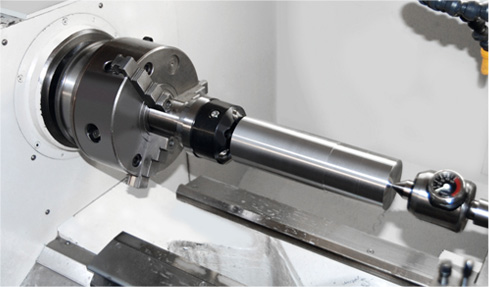CX50 New CNC Turning Lathe Machine Price
Cat:CNC Turning and Polygon Lathe
Are you looking for a machine that combines the capabilities of a CNC lathe and a square lathe? Look no further! Introducing the CX50 New CNC Turning ...
See DetailsIn the process of CNC lathe processing, the processing objects are complex, especially those with changing contours, curves, shapes and positions. In addition, differences in materials and batch sizes increase the difficulty of processing. Therefore, when formulating the processing sequence for specific parts, specific analysis and differentiated treatment should be carried out and handled flexibly. Only in this way can the processing sequence be ensured and rational. Thereby improving production efficiency and harvesting high-quality products. When programming, two levels of issues must be fully considered, one is the processing sequence, and the other is parameters, such as rotation speed, feed amount, and cutting depth.
The processing sequence is generally: drilling , then flattening. This can prevent material shrinkage when drilling; rough machining , then fine machining; process large tolerances and then process small tolerances. The sequence should generally be carried out according to the following principles:
1. The processing of the previous process cannot affect the positioning and clamping of the next process. Comprehensive consideration must also be given to general machine tool processing processes interspersed in the middle.
2. Carry out the inner shape and cavity processing , and then the outer shape processing.
3. For multiple processes carried out in the same installation, the process that will cause less rigid damage to the workpiece should be arranged .
4. Processes processed with the same positioning, clamping method or the same tool should be carried out to reduce the number of repeated positioning, tool changes and platen movements.
5. For internal and external cross-section parts that have both internal surfaces (inner cavities) and external surfaces that need to be processed, when arranging the processing sequence, the internal and external surfaces should be roughed , and then the internal and external surfaces should be finished.
A Turning Centre Machine is a pivotal tool in modern manufacturing, designed to efficiently produce cylindrical components by rotating a workpiece against cutting tools. Its operation revolves around several key components and processes.
The workpiece is securely clamped onto a spindle that rotates it at controlled speeds. Simultaneously, one or more cutting tools, mounted on tool posts, move along multiple axes to remove material from the workpiece's surface. These tools can perform various operations such as facing, turning, grooving, threading, and drilling, depending on the programmed instructions.
The CNC (Computer Numerical Control) system plays a crucial role in automating and controlling the machining process. Operators input machining parameters and tool paths into the CNC unit using programming languages like G-code. The CNC interprets these instructions to precisely position the cutting tools and adjust spindle speeds and feed rates accordingly.
During operation, coolant or cutting fluid is often applied to the cutting zone to lubricate and cool the cutting tools, reducing friction and heat generation. This enhances tool life and improves surface finish quality.
Safety is paramount in Turning Centre Machine operation. Operators must adhere to safety protocols, including wearing appropriate personal protective equipment and ensuring the workpiece and tools are securely clamped and aligned. Regular monitoring of the machining process is essential to detect any anomalies or tool wear that could affect the quality of the machined parts.
Maintenance of CNC Lathe With Sub Spindle
Maintaining a CNC Lathe with a Sub Spindle is crucial for ensuring its performance and longevity. Here’s a breakdown of essential maintenance practices:
Regular lubrication: Proper lubrication of the lathe’s components, including ball screws, slideways, and bearings, is essential to reduce friction and wear. Lubrication schedules should be followed as per the manufacturer’s recommendations to maintain smooth operation.
Cleaning and inspection: Regular cleaning of the machine’s surfaces and components helps prevent the buildup of chips, coolant residue, and debris that can affect performance. Inspection of critical components such as tool holders, turret indexing mechanisms, and spindle bearings should be conducted to detect signs of wear or damage early.
Calibration and alignment: Periodic calibration of axes alignment ensures that the lathe maintains accurate machining tolerances. This includes checking and adjusting the tool offsets, verifying spindle alignment, and ensuring the sub spindle is synchronized correctly with the main spindle for precise machining operations.
Tool maintenance: Tools used in CNC lathes, including inserts and cutting tools, should be inspected regularly for wear and damage. Worn-out tools should be replaced promptly to maintain machining quality and reduce the risk of tool breakage.
Coolant system maintenance: The coolant system plays a critical role in maintaining temperature stability during machining and prolonging tool life. Filters and pumps should be cleaned or replaced as per the manufacturer’s recommendations to prevent contamination and ensure proper coolant flow.
Backup and update CNC programs: Regularly backing up CNC programs and parameters ensures that production can resume quickly in case of a machine failure. Additionally, updating programs to optimize cutting parameters and tool paths can improve efficiency and reduce machining time.
Operator training and safety: Proper training of operators in machine maintenance procedures and safety protocols is essential to prevent accidents and ensure efficient operation. Operators should be familiar with emergency stop procedures and regularly conduct risk assessments to identify and mitigate potential hazards.

